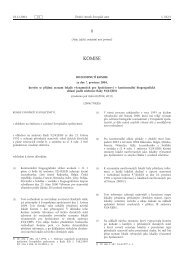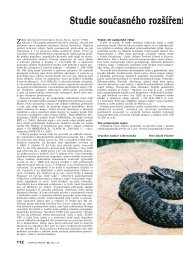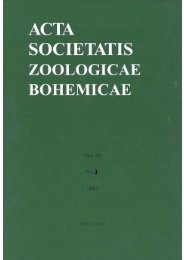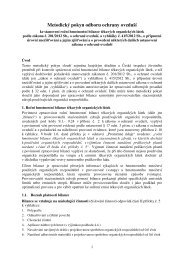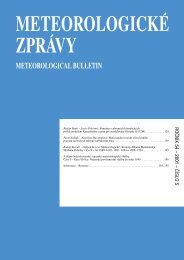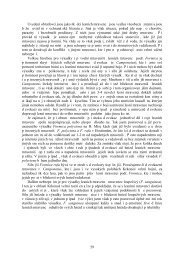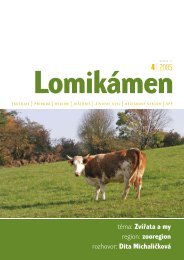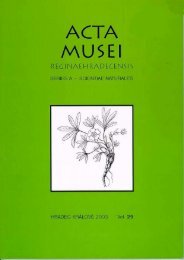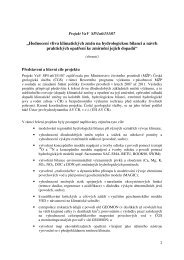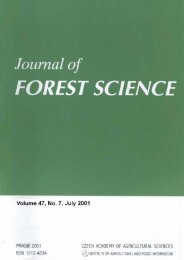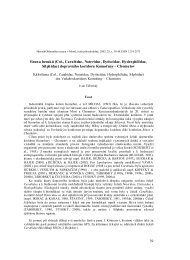Distribution and taxonomy of some Synapsis species, with ...
Distribution and taxonomy of some Synapsis species, with ...
Distribution and taxonomy of some Synapsis species, with ...
Create successful ePaper yourself
Turn your PDF publications into a flip-book with our unique Google optimized e-Paper software.
Thanatophilus sinuatus (Fabricius, 1775)<br />
Silpha sinuata Fabricius, 1775: 75.<br />
Thanatophilus sinuatus var. obscurior Portevin, 1926: 40; syn. n.<br />
Thanatophilus sinuatus var. scutellatus Portevin, 1926: 40; syn. n.<br />
Thanatophilus sinuatus var. cyanescens Portevin, 1943: 47; syn. n.<br />
Thanatophilus sinuatus cypriotus Portevin, 1943: 47; syn. n.<br />
TYPE MATERIAL EXAMINED. HT male <strong>of</strong> Thanatophilus sinuatus var. obscurior (MNHN, coll. M. Pic / G. Portevin),<br />
labelled “(male symbol) [hw] // Finl<strong>and</strong>ia [hw] // MUSÉUM PARIS / COLL. M. PIC [p] // var. obscurior / m. [hw,<br />
Portevin’s MS] // TYPE [p, red label] // Thanatophilus / sinuatus / (Fabricius, 1775) / Jan R%ži!ka det. 2002 [p]”.<br />
HT male <strong>of</strong> Thanatophilus sinuatus var. scutellatus (MNHN, coll. M. Pic / G. Portevin), labelled “Colombes<br />
23.7. [19]21 [hw] / G. Portevin [p] // MUSÉUM PARIS / COLL. M. PIC [p] // var. scutellaris [sic!] / m. [hw, Portevin’s<br />
MS] // Thanatophilus / sinuatus / (Fabricius, 1775) / Jan R%ži!ka det. 2002 [p]”.<br />
HT male <strong>of</strong> Thanatophilus sinuatus var. cyanescens (MNHN, coll. generale), labelled “Zagouan / Tunis centr.<br />
[p] // T. sinuatus / var. cyanescens / m. [hw, Portevin’s MS] // TYPE [p, red label] // Museum Paris [p] //<br />
Thanatophilus / sinuatus / (Fabricius, 1775) / Jan R%ži!ka det. 2002 [p]”.<br />
HT female <strong>of</strong> Thanatophilus sinuatus cypriotus (MNHN, coll. generale), labelled “Limassol / Cyprus [p] // Th.<br />
sinuatus / var. [sic!] cypriotus / Port. [hw, Portevin’s MS] // TYPE [p, red label] // MUSÉUM PARIS [p] //<br />
Thanatophilus / sinuatus / (Fabricius, 1775) / Jan R%ži!ka det. 2002 [p]”.<br />
COMMENTS. Thanatophilus sinuatus is a common <strong>species</strong>, distributed throughout the Palaearctic<br />
region (Schawaller 1981).<br />
Portevin (1926) described Thanatophilus sinuatus var. obscurior from Finl<strong>and</strong> (<strong>with</strong>out details<br />
<strong>of</strong> locality), based on a fine variation in colour (dark coloration <strong>of</strong> scutellum <strong>and</strong> its dark pubescence).<br />
The holotype specimen has greasy pubescence on scutellum <strong>and</strong> is identical <strong>with</strong> T.<br />
sinuatus, having black ultimate abdominal segments <strong>and</strong> a smooth elytral surface <strong>with</strong> three costae<br />
<strong>and</strong> a denticle present on humeral portion <strong>of</strong> elytra.<br />
Portevin (1926) described Thanatophilus sinuatus var. scutellatus <strong>with</strong>out mentioning a type<br />
locality. The holotype specimen bears a locality label <strong>with</strong> the name Colombes, which is a settlement<br />
west <strong>of</strong> Paris in the French department Haute de Seine (N. Berti, personal communication). Portevin<br />
(1926) distinguished this variety based on shape <strong>and</strong> colour <strong>of</strong> scutellum, which should be paler<br />
laterally, covered by pale setation. In fact, the holotype specimen is subteneral, but otherwise identical<br />
<strong>with</strong> T. sinuatus, <strong>with</strong> an identical combination <strong>of</strong> characters to those given above.<br />
Portevin (1943) described Thanatophilus sinuatus var. cyanescens from western Tunisia, based<br />
on slight external differences (heavily punctured <strong>and</strong> glossy dorsal part <strong>of</strong> body <strong>with</strong> distinct blue<br />
metal reflection). The holotype specimen is little more glossy, but otherwise identical <strong>with</strong> T.<br />
sinuatus, <strong>with</strong> an identical combination <strong>of</strong> characters to those given above.<br />
Finally, Portevin (1943) described Thanatophilus sinuatus cypriotus from Cyprus, based on a<br />
single specimen <strong>with</strong> large body, pale setation on pronotum <strong>and</strong> fine punctuation on elytra. The<br />
holotype specimen is larger (combined length <strong>of</strong> pronotum <strong>and</strong> elytra is 11.0 mm), <strong>with</strong> more<br />
elongate elytra, but otherwise identical to T. sinuatus, including the setation on pronotum <strong>and</strong><br />
punctation on elytra, <strong>with</strong> an identical combination <strong>of</strong> characters to that given above.<br />
Consequently, I consider Thanatophilus sinuatus var. obscurior Portevin, 1926, Thanatophilus<br />
sinuatus var. scutellatus Portevin, 1926, Thanatophilus sinuatus var. cyanescens Portevin, 1943<br />
<strong>and</strong> Thanatophilus sinuatus cypriotus Portevin, 1943 as junior subjective synonyms <strong>of</strong> Thanatophilus<br />
sinuatus (Fabricius, 1775).<br />
A c k n o w l e d g e m e n t s<br />
I am especially grateful to Nicole Berti (MNHN), M. J. D. Brendell <strong>and</strong> H. Mendel (both BMNH), G. Burgio <strong>and</strong><br />
F. Santi (both IEUS), J. Jelínek (NMPC), J. Schneider (Mahakam, Praha) B. Jäger <strong>and</strong> M. Uhlig (ZMHB), M. G.<br />
Volkovitsh (ZISP) <strong>and</strong> L. Zerche <strong>and</strong> D. Ahrens (DEIC) who loaned me specimens. Nicole Berti (MNHN) <strong>and</strong> L.<br />
317



